#hemaris thysbe hummingbird clearwing moth
Text

ig - afternoondreams
#kelli soukup#nature#photography#insects#bugs#botany#botanical#floral#flora#august#september#plants#flowers#garden#flower garden#cottagecore#hemaris thysbe hummingbird clearwing moth#hummingbird moth#nature photography#butterfly#butterflies#dreamy#aesthetic#peaceful#magical#calming#art#photographers#kansas#moths
77 notes
·
View notes
Text



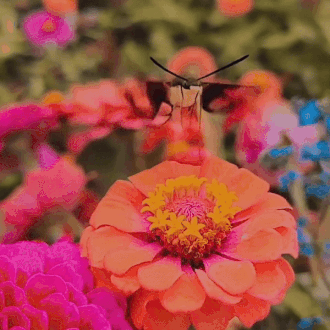
hummingbird clearwing moth (hemaris thysbe) | moanrchmanorfl on ig
#stim#moths#nature#bugs#sfw#pink#orange#brown#black#blue#insects#i believe this is a hummingbird clearwing moth but i'm not 100% sure so plz let me know if i'm wrong#animals#flowers#plants#hummingbird clearwing moth#hemaris thysbe#wings#ishy gifs#postish
3K notes
·
View notes
Text
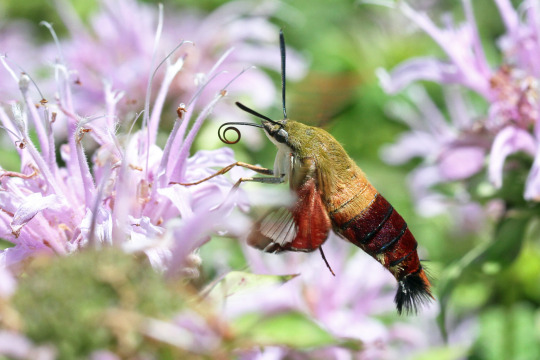
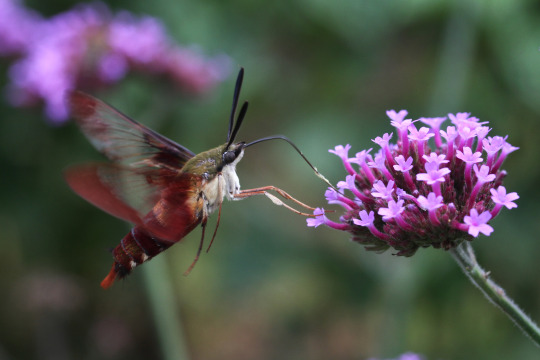

Fond of pink
Hummingbird Clearwing moths (Hemaris thysbe)
Midsummer 2023
Southeastern Pennsylvania
#moth#moths#photographers on tumblr#Hemaris thysbe#hummingbird moth#hummingbird clearwing#bugs#bug#bugblr#entomology#insects#insect#lepidoptera#nature#animals#pink
3K notes
·
View notes
Text
Moth of the Week
Hummingbird Clearwing Moth
Hemaris thysbe
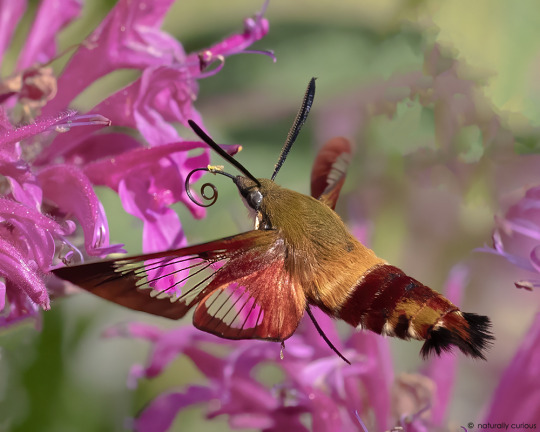
The hummingbird clearwing moth is a part of the family Sphingidae or the hawkmoth family and was first described by Johan Christian Fabricius in 1775. The name Hemaris Thysbe is thought to be a reference to Thisbe, one of the doomed lovers in Ovid's Metamorphoses, due to the color of Thisbe’s blood-stained scarf and the maroon color of the moth. Additionally, the name hummingbird clearwing is due to the humming noise created by the rapid flapping of the moth’s transparent wings.
Description The hummingbird clearwing moth typically has an olive green and maroon back with a white or yellow and maroon underside. It has pale legs and no stripes, which is how you tell this moth apart from other in its genus, Hemaris. Its wings are transparent with a maroon border. After hatching, the hummingbird clearwing’s wings are a fully opaque dark red to black. Then the wing’s scales fall off when the moth takes flight, resulting in a clear wing with maroon borders and visible veins. However, a moth’s color and wing patterning varies between individual moths. For example, moths born in the south or later in the mating season are darker in color, and different populations have varying wing border shapes.
Average wingspan of 4.75 cm (≈1.9 in)
Up to 70 wingbeats per second
Can fly up to 12 mph (≈19.3 kph)
Diet and Habitat When in their caterpillar stage, these moths eat the leaves of cherry trees, European cranberry bushes, hawthorns, dogbane, honeysuckle, and snowberry bushes. Adult hummingbird moths feed on the nectar from flowers such as the Wild Bergamot and beebalm, red clovers, lilacs, phloxs, snowberry, cranberry, blueberry, vetch and thistle. The hummingbird clearwing prefers purple and pink flowers. They use their long proboscis or feeding tube to collect nectar from the flowers while flying in front of it like a hummingbird.
The average proboscis is 20 mm (≈0.8 in)
These moths are the most common in southern Ontario and the eastern United States. Their habitat ranges from Alaska to Oregon in the west and from Newfoundland to Florida in the east. They migrate northward from April to August and southward in late spring and the fall. They inhabit forests, meadows, and suburban gardens.
Mating The hummingbird clearwing has two broods a year in the south, but only one in the north. Mating takes place in May and June as females attract males with pheromones produce from glands at the tip of the abdomen. Female hummingbird moths will lay 200 eggs that will hatch in only 6 to 8 days.
Predators Hummingbird moths and caterpillars in general are hunted by birds, mantids, spiders, bats. To help protect themselves, these types of moths resemble hummingbirds or bees to fool predators.
Fun Fact Adults hummingbird clearwing moths are most active during the hottest parts of the day and have no hearing abilities due to a lack of “hearing organs.”
(Source: Wikipedia, Life On CSG Pond, United States Department of Agriculture, Georgia Wildlife Federation, Beyond Pest Control)
#animals#bugs#facts#insects#libraryofmoths#moth#mothoftheweek#lepidoptera#Sphingidae#hummingbird clearwing moth#Hemaris thysbe
107 notes
·
View notes
Text
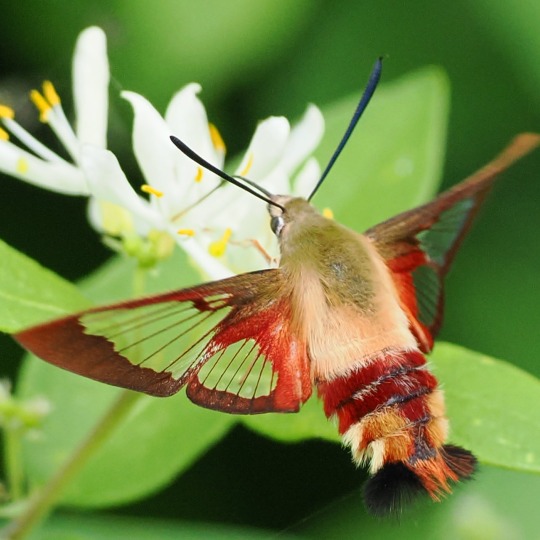
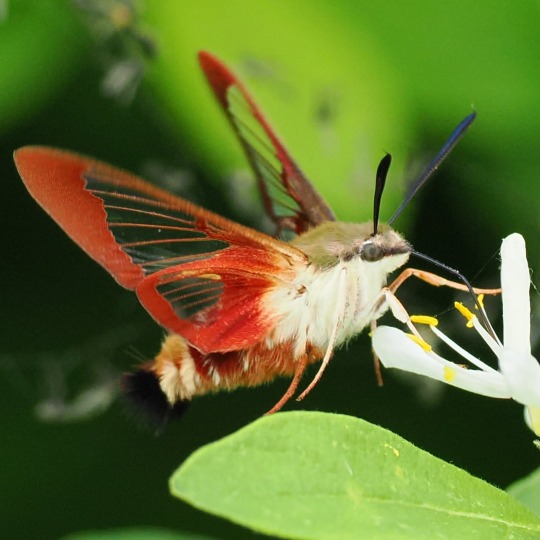
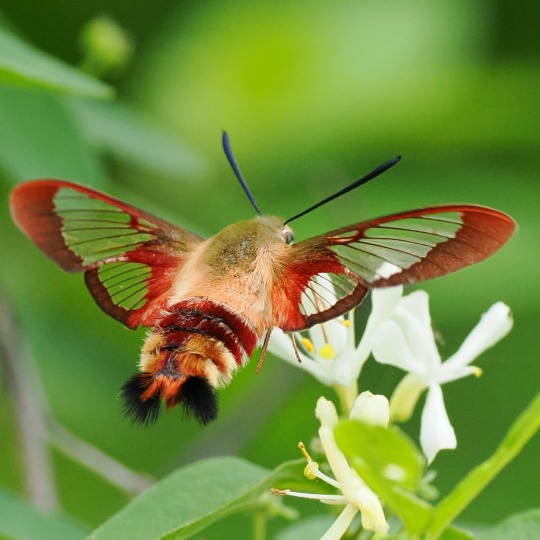
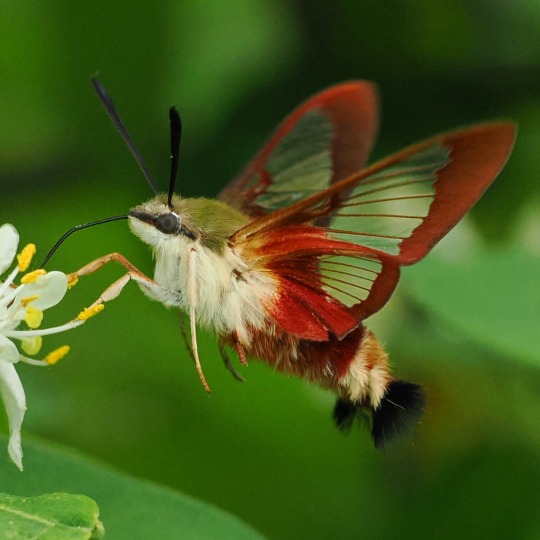
538 notes
·
View notes
Photo

A hummingbird clearwing moth (Hemaris thysbe) finds sustenance from wild bergamot (Monarda fistulosa).
#appalachia#vandalia#west virginia#summer#wildflower#lepidoptera#hemaris thysbe#hummingbird clearwing moth#monarda fistulosa#wild bergamot
69 notes
·
View notes
Text
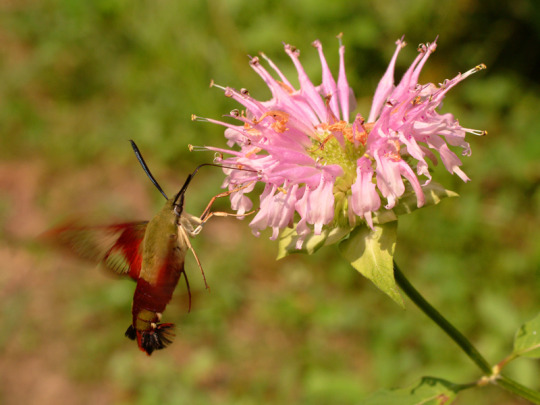
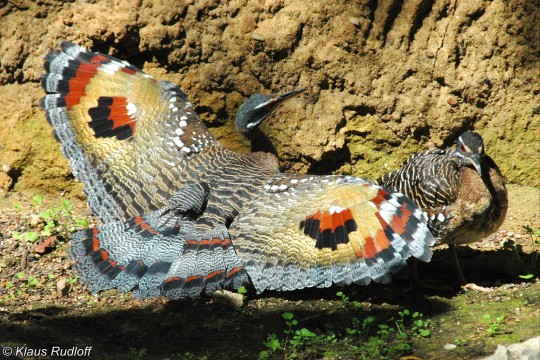
The two opposite ends of the spectrum. A moth that is so bird to me, and a bird that is so moth to me.
Hummingbird clearwing (Hemaris thysbe)
Sunbittern (Eurypyga helias)
429 notes
·
View notes
Text
Hummingbird Hawk Moths: as a result of their hummingbird-like behavior and appearance, these moths are often mistaken for actual hummingbirds
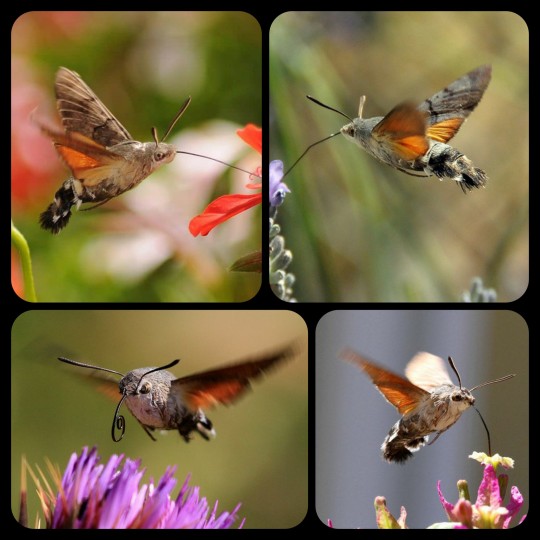
The Eurasian hummingbird hawk moth: Macroglossum stellatarum
Like an actual hummingbird, the hummingbird hawk moth uses a flight maneuver called "swing-hovering" (rapidly swinging from side-to-side while hovering in mid-air), has a wing-speed of up to 85 beats-per-second, produces a humming noise when flying, and feeds on the nectar from flowers; the hairs on its body even resemble the tail-feathers and wings of a hummingbird.
These moths are also able to maintain a stable position in mid-air by relying on the same flight patterns that are found among hummingbirds -- the moth rapidly rotates its wings in a "figure-8" motion, generating lift on both the forward and backward strokes, which effectively allows the moth to hover in place. The flight maneuvers (and other adaptations) of the Eurasian hummingbird hawk moth are so similar to the characteristic traits found in hummingbirds that this little moth is often mistaken for a real hummingbird, despite the fact that it is found exclusively in habitats that do not contain any wild/native hummingbirds. Though this species can be found in various ecosystems throughout the British Isles, mainland Europe, Central Eurasia, and even some parts of North Africa, there are no actual hummingbirds in any of these regions, as wild hummingbirds are found only in the Americas.
These moths (M. stellatarum) have a wing-speed of up to 85 beats-per-second. For comparison, the amethyst woodstar hummingbird, which is one of the smallest and fastest hummingbirds in the world, has a similar wing-speed of up to 80 beats-per-second.

While most other moths are nocturnal, the hummingbird hawk moth is active only during the day. It uses a specialized proboscis to feed on the nectar from various flowers, including honeysuckle, jasmine, tulip, red valerian, lilac, and phlox. This species also differs from other moths due to its lack of auditory organs, meaning that it has no sense of hearing. Among most moths, auditory organs have evolved as a defense mechanism to detect the ultra-sonic chirps that are emitted by predatory bats at night, but because the hummingbird hawk moth is only active during the day, when bats are largely inactive, that particular defense mechanism was not developed.
Experts generally believe that the similarities shared by hummingbirds and hummingbird hawk moths actually arose through convergent evolution; this means that the hummingbirds and the moths both experienced a similar set of needs, pressures, and circumstances within their respective environments, and they simply developed similar adaptations in response to those circumstances. Their uncanny resemblance therefore does not qualify as a form of animal mimicry -- the moths may look and act a lot like hummingbirds, but the resemblance is viewed as a product of incidental factors, and it is unlikely that those similarities were developed for the purpose of providing camouflage.
This is not the only type of moth that is commonly referred to as a "hummingbird moth." The genus Macroglossum contains several moth species that have hummingbird-like characteristics, and the term "hummingbird moth" can be applied to many of them; there are also at least five "hummingbird moths" in the genus Hemaris, although they belong to a separate clade and their resemblance to hummingbirds is somewhat less convincing. They include H. thysbe (also known as the hummingbird clearwing moth), H. diffinis (the snowberry clearwing moth), H. thetis (the Rocky Mountain clearwing moth), H. aethra (the Diervilla clearwing moth), and H. gracilis (the slender clearwing moth), all of which are found in North America.

Moths of the genus Hemaris: these moths may sometimes be identified as "hummingbird moths;" the genus Hemaris also contains a variety of moths that are popularly referred to as "bee hawk moths" or "bee moths" because they bear a resemblance to bumble-bees.
The Eurasian hummingbird hawk moth is not closely related to any of the "hummingbird moths" from the genus Hemaris, however, as it belongs to a completely different genus and occupies a separate habitat on the other side of the Atlantic. Still, it's interesting to note the presence of similar hummingbird-like traits within these different genuses.
Sources & Addition Info:
PBS Nature: Featured Creature, the Hummingbird Hawk Moth
The Wildlife Trusts: Hummingbird Hawk Moth
Royal Society for the Protection of Birds: Article about Hummingbird Hawk Moths
Journal of Comparative Physiology: Fuelling on the Wing: the sensory ecology of hawk moth foraging
Country Life: The Confusingly Enormous Hummingbird Hawk Moth that Looks Set to Become a Regular Fixture in British Gardens
#moths#cute moth#tw bugs#hummingbird#hummingbird hawk moth#insect#entomology#evolution#science#nature#lepidoptera#biology#I spend way too much time reading about moths#but they are just wildly underrated
628 notes
·
View notes
Text
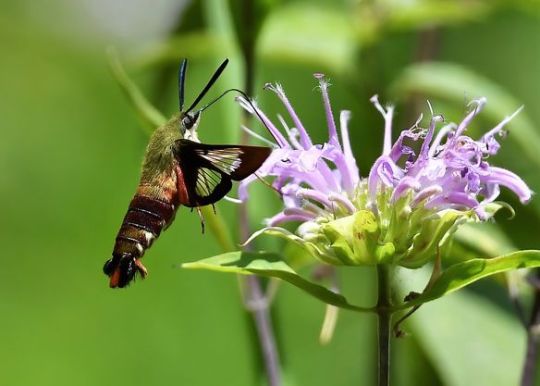
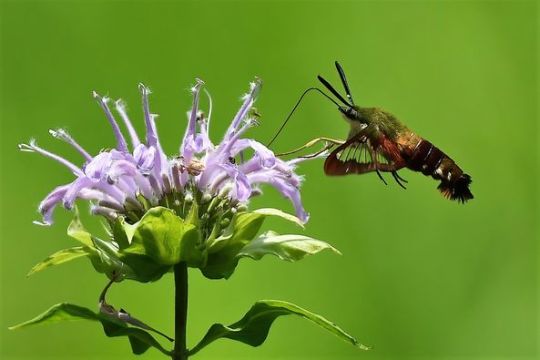
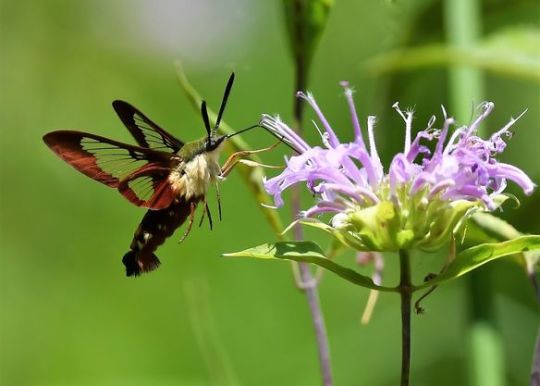
Hummingbird Clearwing Moth, Hemaris thysbe, family Sphingidae, East Fork State Park, southern Ohio, USA
photographs by Gayle Pille
254 notes
·
View notes
Text


Clearwing moths my beloved, that’s the post
but if you want a little bit of information, hummingbird Clearwing moths, Hemaris thysbe, are a diurnal member of the Sphinx Moth family. Due to their shape and hovering flight they are often mistaken for bees or hummingbirds
Clearwing moths are native to the eastern United States, their host plants being Coral honeysuckle and Arrowwood Viburnum if you’d like to attract some to your garden
fun fact, I actually took these pictures
18 notes
·
View notes
Text
cheerycheesecake
your favorite bug!
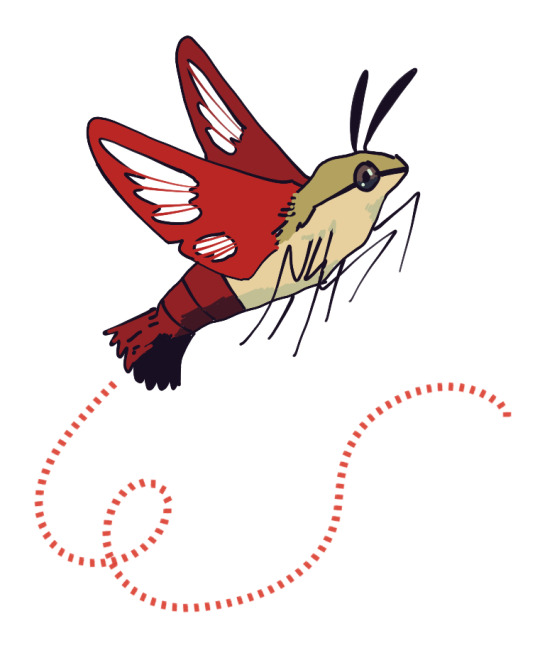
Hemaris Thysbe, aka the clearwing hummingbird moth
it’s hard to choose a favourite bug, but I consider this one my ‘bugsona’ of sorts
7 notes
·
View notes
Text
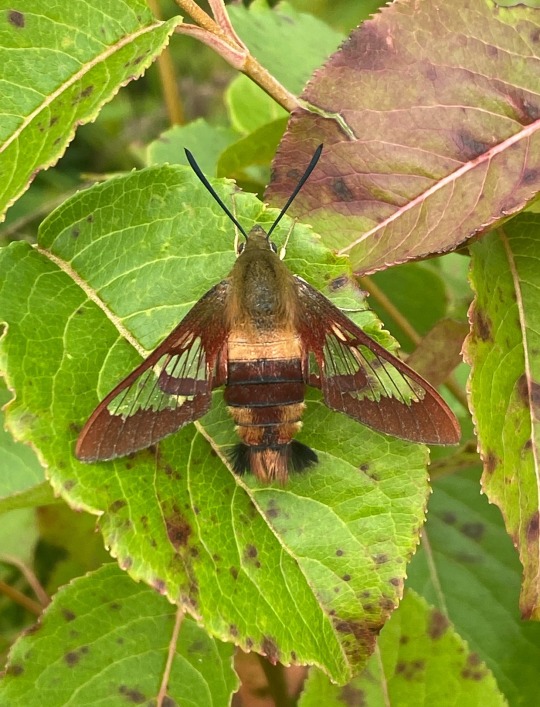
Hemaris thysbe, or the Hummingbird Clearwing, was a moth I found frequently while doing fieldwork this past summer. I honestly thought it was a bird at first, like many people do, until I saw the light shine through its wings.
I can’t believe we exist in the world with such amazing creatures.
#entomology#lepidoptera#moth#insects#my coworker was so nonchalant about it too#like yeah that’s the beautiful bug that functions like a hummingbird and you can hear the frantic beating of its wings from afar#but no big deal#WHAT
11 notes
·
View notes
Note
Random! Very random! Give me a bug! Name one! Come on!
Sure! Hemaris thysbe. The hummingbird clearwing. They’re silly looking moths that also look like hummingbirds.
20 notes
·
View notes
Photo

Hummingbird Clearwing moth (Hemaris thysbe)
July 10, 2022
Southeastern Pennsylvania
#I will post these as often as I can get good photos of them#bug#bugs#photographers on tumblr#hummingbird clearwing#Hemaris thysbe#sphinx moths#insect#insects#nature#animals#bugblr#entomology
522 notes
·
View notes
Text


Clearwing Hummingbird moths!!!
These are a species of moth in the family Sphingidae. They bear striking resemblance to hummingbirds in both their wing flapping and their proboscis.
Hemaris thysbe lives in second-growth forest, in meadows, and is commonly found in cultivated gardens of suburbia. H. thysbe is a migratory species, capable of traveling long distances. In single brood regions, adults are found throughout the summer. In the south, adults are present from March to June and from August to October.
As a caterpillar, H. thysbe feeds on cherry trees, European cranberry bush, hawthorns, dogbane, honeysuckle, and snowberry. It burrows into the soil to overwinter as a brown, hard-shelled pupa. In the late spring, it emerges as an adult moth. H. thysbe lays green eggs on the underside of plant leaves, which hatch in about a week. Development takes four weeks, after which the caterpillar spins a cocoon at ground level. Two to four weeks later a moth emerges for a second breeding cycle before summer's end in southern climates. In northern climates, H. thysbe has a single mating cycle per year.
#nature#naturist#naturism#natural#naturfotografie#naturelover#nature photography#moth answers#moth#insect#bug#cool insects#cute insects#cute insect#insects#bugblr#entomology#cw bugs#cute bugs#bug tw#bugs#cool bugs#entemology#green aesthetic#aesthetics#aesthetic
3 notes
·
View notes
Photo

Hummingbird Clearwing Moth ~ Sphinx Moth ~ Hemaris thysbe ~ Sphinx colibri ~ Romancing a Butterfly Bush ~ Buddleja ~ Buddleia ~ My Yard in Sparta, New Jersey #Hummingbird #HummingbirdClearwingMoth #Sphinx #SphinxMoth #Hemaris #Hemaristhysbe #Sphinxcolibri #Colibri #ButterflyBush #Buddleja #Buddleia #Sparta #NJ #NewJersey #Entomology #macros #macrophotography #macroofinstagram #butterflies #papillons #Flowers #Blossoms #Blooms #insects #insectsofinstagram #Wildlife #wildlifephotography #naturephotography https://www.flickr.com/photos/rachidh/albums (at Sparta, New Jersey) https://www.instagram.com/p/Cg8OLgxuQEu/?igshid=NGJjMDIxMWI=
#hummingbird#hummingbirdclearwingmoth#sphinx#sphinxmoth#hemaris#hemaristhysbe#sphinxcolibri#colibri#butterflybush#buddleja#buddleia#sparta#nj#newjersey#entomology#macros#macrophotography#macroofinstagram#butterflies#papillons#flowers#blossoms#blooms#insects#insectsofinstagram#wildlife#wildlifephotography#naturephotography
2 notes
·
View notes